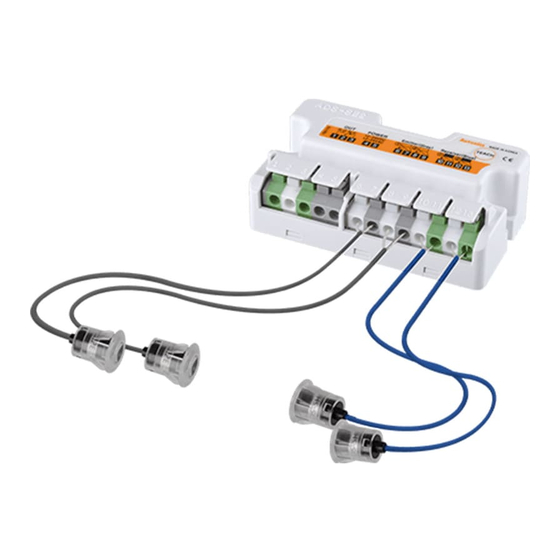Autonics ADS-SE1/2 Manual - Page 4
Browse online or download pdf Manual for Accessories Autonics ADS-SE1/2. Autonics ADS-SE1/2 6 pages. Door side sensor

2. Mount sensor heads to the mounting holes.
When not using the bracket
① One push method
• Put the sensor head into the mounting hole as the figure.
※ Check the nuts are fixed on the sensor body tightly.
※ Install the sensor with no gap between the nut and the
side of the door (or panel).
② Screw method
• Put the sensor head to the mounting hole.
※ Install the sensor with no gap between the panel and the
sensor.
When using the bracket
① One push method
• Put the sensor head to the bracket.
• Fix the bracket to the desired place by screws.
※ Check the nut is fixed to the sensor body tightly.
※ Install the sensor with no gap between the nut and the
side of the door (or bracket).
M4 flat head
screw
Bracket
② Screw method
• Remove the nut and head holder from the sensor head.
• Install the sensor head to the bracket.
• Fix the bracket on the side post of the door by screws.
※ It may cause malfunction because sensitivity setting
is not available as the optical axes are not matched if
sensor body is inclined.
※ Check the damage such as scratches or pollutant on the
lens of the sensor head. It may cause malfunction in the
condition of interrupted light or lack of sensitivity by dust.
①
Nut
Head holder
Economical Door Side Sensor
Through hole for sensor head
: Ø13 to 14mm
Screw hole
: M4 Tap or Ø3.5mm
②
Through hole for sen-
sor head
Bracket
Ø13 to 14mm
Caution for sensor installation
The rated sensing distance is 10m (A).Install the sensors
within the rated sensing distance.
Install the sensor with more than 50cm (B) gap from the
bottom and ceiling. It may cause malfunction by reflected
beams from the surface of the bottom and ceiling.
Do not put obstacles between Emitter and Receiver, or it
may cause malfunction.
This product is for indoor. Avoid the place where
exposed in direct sunlight or it is in over rated intensity of
illumination.
Sensitivity Setting
Sensitivity setting
Sensitivity setting is required when a user installs this unit
at first or there is malfunction due to lack of sensitivity.
Depending on the sensing distance, the controller
automatically sets the optimum sensitivity for the best
operation.
Order of Sensitivity setting
Sensitivity setting
Indicator
key adjustment
Red/Green
Press sensitvity
indicators
setting key
flashe in turn
After 1 sec.
Red/Green
during pressing
indicators turn
sensitivity
OFF
setting key
Red/Green
indicators
flashes
Indicates
Completes
operation
sensitivity
status
setting
※ When pressing the sensitivity setting key below 1 sec.,
the sensitivity setting is canceled and it operates as the
latest setting. If sensitivity is not enough or the setting is
not correct, this unit may have malfunction.
Check the followings when sensitivity setting is
failed.
①Check there are obstacles between Emitter/Receiver
heads.
②Check there is dirt on the head lens of Emitter/Receiver.
③Check the wires are disconnected or connected properly
as the label (connection diagram).
④Check the heads of Emitter/Receiver are inclined.
⑤Check the above items and resolve the problems and
set the sensitivity again.
(A)
Photoelectric
Sensors
(B)
Fiber
Optic
Sensors
(C)
Door/Area
Sensors
(D)
Proximity
Sensors
(E)
Pressure
Sensors
(F)
Rotary
Encoders
(G)
Connectors/
Sockets
(H)
Temperature
Controllers
(I)
SSRs / Power
Controllers
(J)
Counters
(K)
Timers
(L)
Panel
Meters
Status
(M)
Ready
Tacho /
Speed / Pulse
sensitivity
Meters
setting
(N)
Display
Units
Starts
sensitivity
(O)
setting
Sensor
Controllers
Completes
(P)
Switching
sensivitity
Mode Power
setting
Supplies
(Q)
Stepper Motors
& Drivers
& Controllers
(R)
Graphic/
Logic
Panels
(S)
Field
Network
Devices
(T)
Software
C-19
